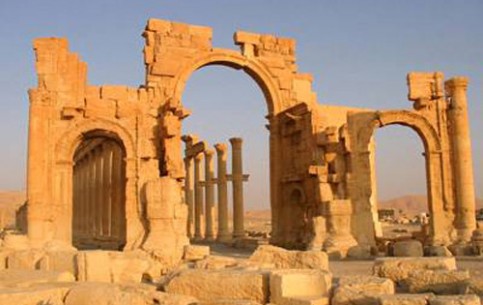
Search:
![]() World Countries
World Countries ![]() Syria
• all objects
Syria
• all objects ![]()
Called the Gateway to History, Syria has a lot to offer history and the development of civilized man. Damascus, Syria's capital claims to be the oldest continuously inhabited capital in the world.
Bordering Lebanon, the Mediterranean Sea, Israel, Jordan, Iraq and Turkey, Suriya is one of the larger states of the Middle East and has its capital in Damascus. A country of fertile plains, mountains and deserts, it is home to diverse ethnic and religious groups, including Kurds, Armenians, Assyrians, Alawite Shias and Druze, as well as the Arab Sunnis who make up a majority of the Muslim population. The modern state of Syria was formerly a French mandate and attained independence in 1946, but can trace its roots to the fourth millennium BC.Its capital city, Damascus, was the seat of the Umayyad Empire and a provincial capital of the Mamluk Empire. Established between 8,000 to 10,000BC, Damascus is credited with being the oldest continuously inhabited city in the world. Its position in the verdant Ghouta oasis and its proximity to the Silk Road led to it being coveted by waves of conquering empires. Egyptians, Assyrians, Persians, Greeks, Romans, Umayyads, Mongols, Turks and the French were all lured by its charms. The old walled city, in particular, feels very ancient and is comprised of a maze of narrow alleys, punctuated by enigmatic doors that lead into pleasing, verdant courtyards and blank-faced houses. Damascus is made up of a sizeable old city, divided into the market area, Muslim area, Christian area and the Jewish area. All three groups are still represented in Damascus, even if the Jewish community now only counts a few thousand. Damascus has more than 200 mosques, but only 70 are still in use. The Grand Mosque, the mosques of Sinani-yah and Tekkeyah are notable among them. There is a direct route from Damascus to the ancient city of Palmyra, and a direct route running to Aleppo, via Homs and Hama. There is also a direct route leading to the Jordanian border, and another through which you can visit Qanawat, Shahba, Bosra and other Southern sites. Situated 140 Km south of Damascus in the Horan plain, is the ancient city of Bosra. It is most famous for magnificent Roman amphitheater, which was later converted into a fortress by the Ayyubids. The original theater, which has been miraculously preserved, seats 15 000 and its stage is 45 meters in length and 8 meters in depth.There are also several attractive sites and monuments: Crac des Chevaliers – the archetypal Crusader castle; Apamea – a former Roman city which once housed about half a million people; the Dead Cities – a series of towns which once formed part of Antioch; Al Bara boasts pyramidal tombs and formerly grand archways set on modern farm land; Serjilla – another famous dead city. Der Mar Musa is not a tourist site, but an active Christian monastery actively promoting Islamic – Christian dialog. Welcomes Christians and followers of other religious traditions.
All tours with a visit to object "Syria" ![]()
YouTube Broadcast video clips
![]() SYRIA
SYRIA
![]() DAMASCUS
DAMASCUS
![]() BOSRA
BOSRA
![]() ALEPPO
ALEPPO
![]() PALMYRA
PALMYRA
![]() Syrie / Krak des chevaliers
Syrie / Krak des chevaliers
![]() Aramaic - Syria
Aramaic - Syria








